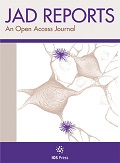Authors: Fowler, Christopher | Rainey-Smith, Stephanie R. | Bird, Sabine | Bomke, Julia | Bourgeat, Pierrick | Brown, Belinda M. | Burnham, Samantha C. | Bush, Ashley I. | Chadunow, Carolyn | Collins, Steven | Doecke, James | Doré, Vincent | Ellis, Kathryn A. | Evered, Lis | Fazlollahi, Amir | Fripp, Jurgen | Gardener, Samantha L. | Gibson, Simon | Grenfell, Robert | Harrison, Elise | Head, Richard | Jin, Liang | Kamer, Adrian | Lamb, Fiona | Lautenschlager, Nicola T. | Laws, Simon M. | Li, Qiao-Xin | Lim, Lucy | Lim, Yen Ying | Louey, Andrea | Macaulay, S. Lance | Mackintosh, Lucy | Martins, Ralph N. | Maruff, Paul | Masters, Colin L. | McBride, Simon | Milicic, Lidija | Peretti, Madeline | Pertile, Kelly | Porter, Tenielle | Radler, Morgan | Rembach, Alan | Robertson, Joanne | Rodrigues, Mark | Rowe, Christopher C. | Rumble, Rebecca | Salvado, Olivier | Savage, Greg | Silbert, Brendan | Soh, Magdalene | Sohrabi, Hamid R. | Taddei, Kevin | Taddei, Tania | Thai, Christine | Trounson, Brett | Tyrrell, Regan | Vacher, Michael | Varghese, Shiji | Villemagne, Victor L. | Weinborn, Michael | Woodward, Michael | Xia, Ying | Ames, David | the AIBL investigators
Article Type:
Research Article
Abstract:
Background: The Australian Imaging, Biomarkers and Lifestyle (AIBL) Study commenced in 2006 as a prospective study of 1,112 individuals (768 cognitively normal (CN), 133 with mild cognitive impairment (MCI), and 211 with Alzheimer’s disease dementia (AD)) as an ‘Inception cohort’ who underwent detailed ssessments every 18 months. Over the past decade, an additional 1247 subjects have been added as an ‘Enrichment cohort’ (as of 10 April 2019). Objective: Here we provide an overview of these Inception and Enrichment cohorts of more than 8,500 person-years of investigation. Methods: Participants underwent reassessment every 18 months including comprehensive
…cognitive testing, neuroimaging (magnetic resonance imaging, MRI; positron emission tomography, PET), biofluid biomarkers and lifestyle evaluations. Results: AIBL has made major contributions to the understanding of the natural history of AD, with cognitive and biological definitions of its three major stages: preclinical, prodromal and clinical. Early deployment of Aβ-amyloid and tau molecular PET imaging and the development of more sensitive and specific blood tests have facilitated the assessment of genetic and environmental factors which affect age at onset and rates of progression. Conclusion: This fifteen-year study provides a large database of highly characterized individuals with longitudinal cognitive, imaging and lifestyle data and biofluid collections, to aid in the development of interventions to delay onset, prevent or treat AD. Harmonization with similar large longitudinal cohort studies is underway to further these aims.
Show more
Keywords: Aβ-amyloid imaging, Alzheimer’s disease, biomarkers, cognition, cohort study, lifestyle, mild cognitive impairment, observational longitudinal, preclinical Alzheimer’s disease, prodromal Alzheimer’s disease
DOI: 10.3233/ADR-210005
Citation: Journal of Alzheimer's Disease Reports,
vol. 5, no. 1, pp. 443-468, 2021





